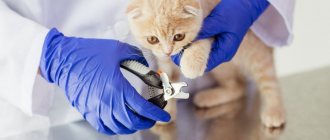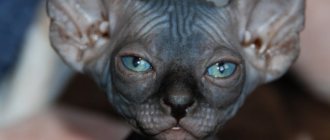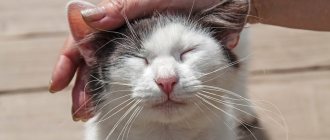Doctors, veterinarians, and animal husbandry and breeding experts are unanimous in their opinion that cats should not be kissed. But what is the reason for this ban? Basically, the argument is made that through kissing a pet (and especially a stray one) you can get an unpleasant disease. But even if the animal is 100% clean of any microbes, fungi and worms, you still shouldn’t touch it with your lips: cats are uncomfortable with such a human act of showing love and they can easily “go on the attack”, trying to protect themselves.
Main reasons for the ban
Cats most often live next to humans not for any specific benefit, because now they practically do not have to catch mice.
A person needs this companion animal, perhaps much more than a cat needs an owner.
These pets give all household members their love, affection and devotion, without demanding anything in return.
It has been noted that people living in the same room with a furry pet are less susceptible to colds and hypertension. Children who grew up with a cat are not prone to allergies, are taught to take care of a pet from an early age, and are more psychologically stable.
Even stroking an animal sitting on his lap, a person receives a lot of positive emotions. However, so does the pet.
But kissing a cat is absolutely unnecessary. A cat does not understand such manifestations of feelings and does not need them. She is quite satisfied with gentle hands and kind words.
Kissing a pet is, first of all, unhygienic.
Although a cat is a clean creature, it is not sterile. The animal uses a litter tray, sometimes eats raw meat, and many microorganisms can live on its fur.
The immunity of cats is of a completely different nature than that of humans and is much stronger. Those pathogenic bacteria that are found on the mucous membranes of the mouth and on the fur can be dangerous for humans.
But there are several versions, besides the opinion of veterinarians, why a cat should not be kissed or even pressed to its face.
Mystical
From time immemorial it was believed that a cat is a carrier of the souls of the dead. Moreover, these legends were passed down from mouth to mouth among many peoples. And they are composed of many cat breeds, for example, Siamese, Sacred Burmese.
The Egyptians believed that cats warded off evil entities by diverting their attention to themselves. In Medieval Europe, they were the embodiment of the spirit of a witch; in Japan, cats were considered bearers of evil.
Apparently this is where the assumption arose that by kissing a cat, a person can become its slave or subject of the entity that it embodies.
Another legend says that with a kiss, a person gives part of his vitality to the cat. And the more often you kiss a pet, the worse the owner will feel. And the idea that a cat loses its sense of smell from kisses is completely absurd.
None of these versions, of course, has any scientific basis.
Psychological
Over many centuries of coexistence, people have become so attached to cats that they cannot even imagine life without them.
The only problem is that cats understand their owners very well, but they don’t always understand their pets.
Cats are usually tired of excessive petting, because these animals are very self-sufficient. They demand to express emotions using the tools that they understand and like.
Not understanding another too violent manifestation of the owner’s love, the cat may decide that they are going to strangle him and begin to take revenge as he knows how and sees fit. Therefore, you should not go after your pet with kisses - he doesn’t like it.
Medical
From a medical point of view, the issue of kissing cats is resolved unequivocally - this should absolutely not be done. After all, people allow themselves tactile contact only with loved ones - parents, family partners, children.
A cat, although a family member for many, belongs to a completely different biological species. And can be a carrier of many zoonotic diseases. Therefore, you should not kiss a cat, much less let children do it.
The benefits of communicating with cats
Scientists have proven that the benefits of communicating with furry pets are undeniable: even the very presence of a cat has a beneficial effect on the owner’s psyche, especially tactile contact when he picks it up and strokes it. In addition to purely moral satisfaction, communication with a pet improves well-being due to:
activation of blood flow; warming the body, which is especially important during inflammatory processes and radiculitis; normalization of blood pressure and heart rate through activation of neurons from contact with cat fur.
In addition, it is noted:
faster and more productive socialization of children with Down syndrome - constant contact with a cat makes it easier to get into contact with society; increasing stress resistance; quick relaxation after a busy day for all people, this is especially important for those whose work involves stress; getting rid of insomnia; reduction of symptoms of “chronic fatigue syndrome”, rapid fatigue disappears.
Thus, the benefits of tactile communication with your pet are undeniable. However, it should be remembered that it is impossible to force a cat to sit with its owner and treat him. The cat will leave if at the moment he did not plan to sit with the owner and purr. There will be no benefit from this, even if you forcibly hold the animal on your knees. It is better to wait until the cat is ready to do this.
Positive and negative effects of cats on human health
In a word, you can and should kiss cats, but at a certain distance. This is optimal contact for both four-legged animals and humans. The cat will feel that the owner loves her and respects her personal space, and the person does not need to be afraid of contracting unpleasant microorganisms or infections.
Attention! A cat and a person belong to different species, which means they have different languages and preferences, and you should not try to force animals to love you by forcibly hugging and kissing them. You can watch a video on the dangers of kissing cats here:
You can watch a video on the dangers of kissing cats here:
Video - What happens if you kiss a cat
https://legkovmeste.ru/domashnie-zhivotnyie/pochemu-nelzya-celovat-koshek.htmlhttps://tailytales.ru/2019/05/05/36628/https://pets-expert.ru/pochemu-nelzya- celovat-koshek/
Possible diseases
There are a number of diseases that a cat can infect humans by being a carrier.
Toxoplasmosis
This is an extremely dangerous parasitic disease transmitted through Toxoplasma, a protozoan single-celled organism.
Today, more than half the adult population of Europe, South and North America is infected—almost 90%. But humans are an intermediate carrier of the parasite. And the main carrier is all cat species. During the short period of the acute phase of the disease, they release from 2 to 3 billion oocysts. Parasites, along with animal feces, enter the environment and, after spirulation, can live in a preserved state for up to three years, waiting for a new carrier.
Cats usually tolerate the disease easily. And it manifests itself in short-term conjunctivitis and diarrhea. Small kittens with intrauterine infection and young animals, especially with concomitant viral infections, can die from toxoplasmosis.
For humans, a cat with toxoplasmosis is dangerous for a very short period of time during the acute phase of the disease and only if the parasite enters directly into the owner’s blood (for example, through bleeding scratches on the hand when the pet licks them). Or if by chance the cat sneezes in the owner’s face.
This is why you should never kiss an animal. In air, oocysts die immediately, and with direct mouth-to-mouth contact they can enter the human body through saliva.
Infection is especially dangerous for a pregnant woman, since there is a high probability of intrauterine infection of the child.
With daily cleaning of the cat litter, infection is impossible, since spirulation, that is, the readiness of Toxoplasma to enter the host’s body, does not occur immediately. This is possible no earlier than in a day (sometimes up to five).
Cat scratch disease - Felinosis
This disease has been known for a long time, but its mechanism was fully described only in the 90s of the last century.
Benign lymphoreticulosis or Molar granuloma is dangerous due to short-term inflammation of the lymph nodes. The disease is transmitted through scratches from a cat’s claws.
More than half of all cats in the world are carriers of Felinosis. Since the infection has been little studied, there is a possibility that the animal’s saliva may contain its pathogens. For this reason, kissing pets is also dangerous.
Pets themselves become infected with Felinosis through fleas. For this reason, it is important to regularly treat them for external parasites.
In a person, after infection, the disease develops over three stages; with sufficiently good internal reserves of the body, it proceeds easily (often asymptomatic) and recovery occurs on its own. The person who has recovered from the disease develops a strong immunity to Felinosis.
Salmonella
This is a zooanthropotic pathology that equally affects cats and humans. It is transmitted by infection of the body with Salmonella bacteria.
They are capable of surviving for up to 2-3 months on human furniture, clothing, and shoes. About six months - on food and excrement, in water and garbage. The bacterium easily tolerates sunlight and temperature changes. -85 ⁰C and +100 ⁰C are destructive for it. But effective disinfection can help get rid of the parasite within half an hour.
Salmonellosis is extremely difficult for newborn kittens and young animals to suffer from. Diarrhea and other dyspeptic symptoms appear, quickly leading to dehydration of the body.
For humans, this disease is also extremely dangerous and difficult to tolerate.
The cat usually gets sick within a day or three after infection. Therefore, kissing a pet is dangerous, in case it has already eaten infected meat and is currently transmitting the pathogen through saliva to its owner.
If any symptoms of pathology appear in a cat or a person, you should immediately contact a veterinarian and doctor. If treatment is carried out on time, consequences can be avoided.
Worm infestation
This disease is carried by a variety of parasitic worms. Refers to zooanthropotic diseases.
You can become infected through food, dirt, soil, feces, saliva of an infected individual, lice, fleas, and other external parasites.
There are a lot of types of worms, about 30 in Russia alone.
The best way to prevent your pets and household from getting helminthic infestations is timely deworming of your pets. Veterinarians recommend performing this procedure once every three months.
At the first signs of pathology, you must contact a specialist and begin treatment. The prognosis is positive.
When kissing a cat, infection can easily occur through saliva, because there is no guarantee that the animal is not infected.
Fungal infections
Ringworm is the most common zooanthropotic disease today, which is easily transmitted from cats to humans. But most often, on the contrary, the owner infects the pet and, without even knowing it, blames the animal.
The fungus can be brought into the house from the street on clothes and shoes, but a cat can easily pick it up at an exhibition or while walking outside. Dog paws are another source of infection.
Treatment methods for lichen today are effective, although the process will take at least a month for both humans and pets.
Hygiene practices must be followed to avoid infection. Kissing a cat, especially a stranger, is strictly prohibited.
There is currently no effective regular vaccine.
Rabies
This is one of the most dangerous diseases in the world, it is equally dangerous for both people and cats.
Rabies has been well studied and described. The salvation of humanity from this infection was the vaccine developed by Louis Pasteur.
It is recommended to vaccinate pets annually to prevent the possibility of infection. But you shouldn’t kiss your own pets, much less unfamiliar animals. In case of infection, any pets must be destroyed; a person in the initial stage can be saved by vaccination.
What do cats think when people kiss them?
How do cats kiss each other? Obviously, completely different from you and me. And animals put a completely different meaning into their “cat caresses.” If the cat wants to express his approval, he can do one of the following actions:
- Blinks both eyes (this is a sign of cat consent).
- It will rub its muzzle and the base of its tail (this is how a cat leaves pheromones on an object that it considers its own).
- He will begin to lick, bite lightly, press with his paws, periodically releasing his claws (these are also all ways to leave his “marks”).
Well-mannered cats will tolerate kisses from their owners, but arrogant animals may bite or scratch
Human kisses are not considered affectionate in the eyes of cats. Just imagine how we look from the animal’s perspective: a large head rapidly reaching towards the cat, for some reason pressing its lips into its muzzle and making a hissing and smacking sound. An animal that lives for a long time surrounded by people will eventually understand that such an action does not threaten it (although it does cause discomfort).
Most likely, the pet will tolerate such a manifestation of love, and especially cunning cats will even use it for their own purposes (if they understand that afterward they will receive the owner’s favor or a treat). But out of ignorance or because of its fearful and distrustful disposition, a cat can see human kisses as a threat, which means it can begin to defend itself.
During a fight, animals not only hiss and scream gutturally, but also smack their lips, which is very similar to the sound made by people when kissing - that’s why our “smacks” for cats are tantamount to an offensive curse
Cats, even among themselves, try not to overdo it with affection. Excessive attention overstrains animals. They can still tolerate a person’s advances for a couple of seconds, but from an excessive number of hugs and kisses they will try to run away - they will begin to hide, shy away from outstretched hands and even scratch and bite, showing that they do not want to be touched.
A light touch of a cat’s nose can be called a kind of kiss, since the animal does this only in relation to “its own”, but the meaning of this gesture is to check what the person smells like - whether he ate something tasty and whether he needs it mark with your pheramones
Prevention measures
In order not to “catch” dangerous zooanthropotic diseases from your own cat, it is enough to follow simple preventive measures:
- Your pet should be regularly dewormed, treated for external parasites, and vaccinated against all known viral infections, including rabies.
- Closely monitor the health of the animal; at the first signs of illness or inappropriate behavior, immediately contact a veterinary clinic.
- Never touch newborn kittens or the female if she is behaving aggressively. Keep children away from them.
- Do not separate fighting cats; you should not approach them at all - at this moment a person can be seriously injured.
- Never tease a cat, play with your bare hands, or throw your pet out of balance.
- You should not touch animals when they sleep, eat, or wash themselves.
- You should never kiss cats - neither domestic pets, nor, especially, strangers or street ones.
In addition, it is necessary to observe the rules of personal hygiene and clean and disinfect the cat's litter box every day, wash water and food bowls.
Wet cleaning of the house, if a pet lives in it, should also be carried out every day, and regular general cleaning - with the use of disinfectants and the use of a steam generator.
Something about cat hygiene
A cat, in general, is a very clean animal; it cannot be called dirty. She defecates in certain places, “cleans up” after herself, constantly licks herself, and loves to rest in clean places. But most cats have fur, and this is an excellent habitat for many parasites. If you kiss a pet, contact with microorganisms is inevitable.
Pets that live indoors and do not go outside are unlikely to become infected with fleas. But dust mites can accumulate in their fur, which are invisible to the human eye. Microscopic mites are a source of severe allergies. By and large, you can’t not only kiss a cat, you can’t even touch the animal’s fur with your face
A domestic cat trained to a litter box will always go to this place. But often she gets her paws dirty in feces, and then spreads her footprints around the apartment. They may also be invisible, but in such an environment much more microbes accumulate. Even the most hygienic owner does not attach much importance to this fact. However, when trying to kiss a cat, people notice a large number of microorganisms on the skin.
Among other things, the “mustachioed-striped” ones have a completely different immunity. They are more resistant to pathogenic microbes than humans. The cat may not get sick itself, but it will be a carrier of viruses, bacteria, and fungi that are dangerous to human health. They are transmitted by kissing an animal. Many infections cannot be noticed and do not cause symptoms in the carrier.
Based on this, we can draw an unambiguous conclusion: cat petting is not hygienic, even if the pet looks clean and well-groomed. Kissing a cat is dangerous.











